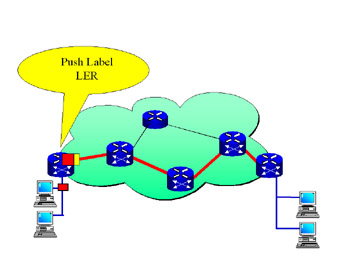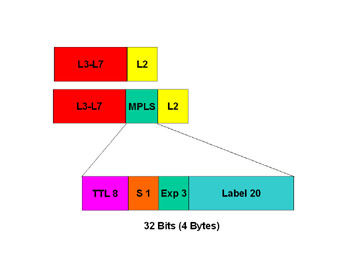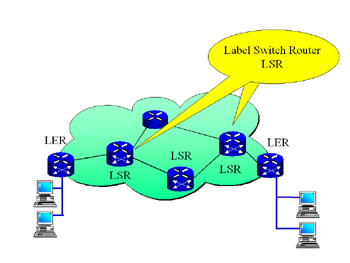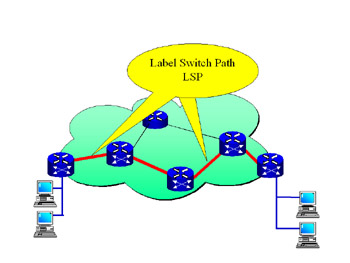MPLS Network Construction
|
| < Day Day Up > |
|
In an IP network, you can think of routers as post offices or postal sorting stations. Without a means to mark, classify, and monitor mail, there would be no way to process different classes of mail. In IP networks, you find a similar situation. Figure 1.1 shows a typical IP network with traffic having no specified route.

Figure 1.1: IP Network
In order to designate different classes of service or service priorities, traffic must be marked with special labels as it enters the network. A special router called a label edge router (LER) provides this labeling function (see Figure 1.2). The LER converts both IP packets into MPLS packets and MPLS packets into IP packets. On the ingress side, the LER examines the incoming packet to determine whether the packet should be labeled. A special database in the LER matches the destination address to the label. An MPLS shim header, as shown in Figure 1.2, is attached, and the packet is sent on its way.

Figure 1.2: IP Network with LERs and IP Packet with Shim Header Attached
To further understand the MPLS shim header, let’s look at the Open Systems Interconnection (OSI) model. Figure 1.3a shows OSI Layers 7 through 3 (L7–L3) in dark grey, and Layer 2 (L2) is shown in grey. When an IP packet (Layers 2–7) is presented to the LER, it pushes the shim header (b) between Layers 2 and 3. Note that the shim header, while part of neither Layer 2 nor Layer 3, provides a means by which to relate both Layer 2 and Layer 3 information.

Figure 1.3: MPLS Shim Header and Format
The shim header (c) consists 32 bits in four parts; 20 bits are used for the label, three bits for experimental functions, one bit for stack function, and eight bits for time to live (TTL). It allows for the marriage of ATM (a Layer 2 protocol) and IP (a Layer 3 protocol).
In order to route traffic across the network once labels have been attached, the non-edge routers serve as label switch routers (LSRs). Note that these devices are still routers. Packet analysis determines whether they serve as MPLS switches or routers.
The function of the LSR is to examine incoming packets. Provided that a label is present, the LSR will look up and follow the label instructions and then forward the packet according to the instructions. In general, the LSR performs a label-swapping function. Figure 1.4 shows LSRs within a network.

Figure 1.4: Label Switch Routers
Paths are established between the LER and the LSR. These paths are called label switch paths (LSPs). The paths are designed for their traffic characteristics; as such, they are very similar to ATM path engineering. The traffic-handling capability of each path is calculated. These characteristics can include peak-traffic load, interpacket variation, and dropped-packet percentage calculation.
Figure 1.5 shows the LSP established between MPLS-aware devices. Because MPLS works as an overlay protocol to IP, the two protocols can co-exist in the same cloud without interference.

Figure 1.5: Label Switch Paths
|
| < Day Day Up > |
|
EAN: 2147483647
Pages: 138